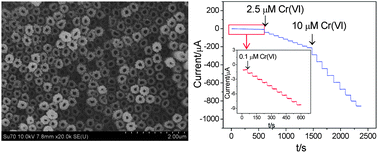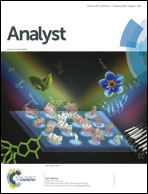Sensitive and selective electrochemical detection of chromium(vi) based on gold nanoparticle-decorated titania nanotube arrays
Abstract
Owing to the severe toxicity and mobility of Cr(VI) in biological and environmental systems, it is of great importance to develop convenient and reliable methods for its detection. Here we report on a facile and effective electrochemical technique for monitoring Cr(VI) concentrations based on the utilization of Au nanoparticle-decorated titania nanotubes (TiO2NTs) grown on a titanium substrate. It was found that the electrochemical reduction of Cr(VI) at the Ti/TiO2NT/Au electrode exhibited an almost 23 fold improvement in activity as compared to a polycrystalline gold electrode, due to its nanoparticle/nanotubular heterojunction infrastructure. As a result, the Ti/TiO2NT/Au electrode demonstrated a wide linear concentration range from 0.10 μM to 105 μM, a low detection limit of 0.03 μM, and a high sensitivity of 6.91 μA μM−1 Cr(VI) via amperometry, satisfying the detection requirements of the World Health Organization (WHO). Moreover, the Ti/TiO2NT/Au electrode exhibited good resistance against interference from coexisting Cr(III) and other metal ions, and excellent recovery for Cr(VI) detection in both tap and lake water samples. These attributes suggest that this hybrid sensor has strong potential in applications for the selective detection of Cr(VI).


 Please wait while we load your content...
Please wait while we load your content...